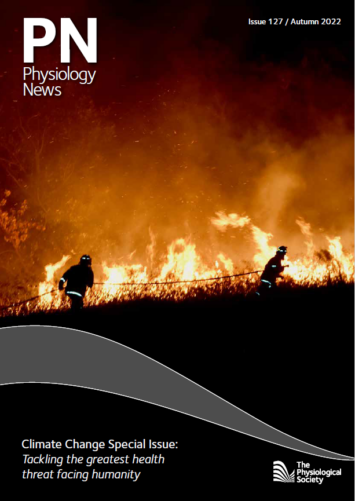
Physiology News Magazine
Book Review
Life Before Birth: Challenges of Fetal Development by Peter Nathanielsz
News and Views
Book Review
Life Before Birth: Challenges of Fetal Development by Peter Nathanielsz
News and Views
https://doi.org/10.36866/pn.127.14
Dr Christopher Torrens
Royal College of Surgeons, Republic of Ireland
There is a familiar trope that there are only three certainties in life: death, taxes and overblown introductions to a book review or perhaps some other appropriate third option. This theme has its origins in the combination of Benjamin Franklin’s observation that there are two certainties in life; “death and taxes” with the much older proverb with three certainties. That older proverb suggested that those certainties in life were birth, death and change. While this proverb clearly seeks to emphasise that nothing in life is set in stone, it clearly takes birth for granted as a certainty and considers this to be the starting point for life. I suppose this is not unreasonable. The proverb is certainly old, while as late as the 17th century the eminent embryologists and physiologists William Harvey and Marcello Malpighi were advocating preformationism – that organisms develop from miniature versions of themselves. The trials and tribulations of the life before birth were unknown then, but they are not now and they are brilliantly and comprehensibly presented by Professor Peter Nathanielsz, University of Wyoming, US in his book.
From the development of gametes through fertilisation, organ development, growth and maturation before and ultimately birth this book packs a lot into its 300 odd pages. This timeline of growth and maturation gives the book some of its inherent structure, although in some respects it could be seen as a book of two halves. The first part addressing “normal” fetal growth and then, having given the reader enough background, the second part sets out to highlight the challenges and adaptations that can occur during development and the long-term consequences of these to the individual and society.
This structure works well. There are some who undoubtedly want the author’s guiding hand to shepherd them through the material in an order as laid out. Each chapter builds on the last and occasionally digresses to some more general biology topics (such as genetics or cell communication) to provide context for the main thrust. For others though, perhaps a more cherry-picked approach is preferable, and maybe it is the placenta or the fetal cardiovascular system that specifically piques their interest. For those readers this works too, as each chapter stands alone and like every good textbook it is well integrated with references to the other chapters where more detail can be found.
In these first chapters, the author takes us from fertilisation to blastocyst formation, via a brief side swerve into cell biology. From
there we learn about the development of organs: the placenta, the cardiovascular system, the GI tract and the brain and senses. In describing this last part the author recounts hearing Pasco Rakic present data on the development of the visual cortex; it is one of a few personal reflections that appear throughout and speak to the relatability of the text and the author’s obvious enthusiasm for the subject. Some other highpoints in the first section are the sections on fetal circadian rhythm as well as the important issues around the effects of drugs and smoking on the developing fetus.
Having set up the normal in the first chapters and foreshadowed adverse environments in in the chapter on smoking, the book shifts gear in the second half as it moves into the developmental programming chapters. These chapters offer a whistlestop tour of the challenges to the fetus and of the concepts and methodologies of developmental programming. In the last 30 years there has been an explosion in research in this field and with it reviews, textbooks and other popular science books. It is wrong, however, to compare this book to those, as this is not a book about programming per se. This is, as it says, a book about life before birth, while much of the programming work is specifically interested in the consequences, and often quite long-term consequences, of perturbations to the fetal environment. What it does present is an excellent, wellreferenced and easily readable series of chapters that give an important overview that fits with the scope of this book. From giving an overview of what programming is and the models that have been used to study it, the book also gives an overview of some of the research across different challenges (such as maternal hypoxia or obesity) and their impact on the various systems of the offspring (cardiovascular, metabolic etc).
Aside from the engaging language and writing style, what puts this firmly in the category of popular science is the final chapter, written by Professor Lucilla Poston. It is an important final chapter that sets out the agenda of what we should do with this knowledge in a way that no textbook ever would (or should). We now know far more about fetal development and the importance of nutrition during pregnancy, and even before in the pre conceptional period for both mothers and fathers, but how do we put this into use. Just as with Liggins’ work with cortisol for promoting lung maturation in premature infants or Smithells’ work with vitamins and folate for the prevention of neural tube defects, how do we take this understanding and turn it to addressing issues that still persist in antenatal care, such as spontaneous premature birth or poor placental function? It turns out that birth is not really a certainty of life, but enjoying this book might well be one such certainty.
To hear the latest pregnancy research, register for an exciting one-day meeting in London on 29 September “Environmental Impacts on Pregnancy and Offspring Outcomes: Lessons Learned and Avenues for Intervention”. The meeting will explore how to mitigate the negative impacts of adverse environmental conditions on the lifelong health of the mother and child.
